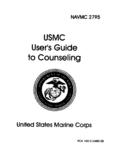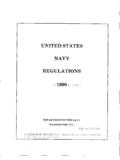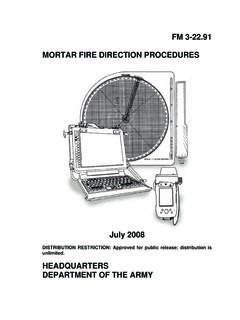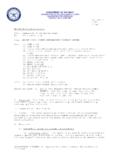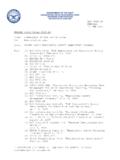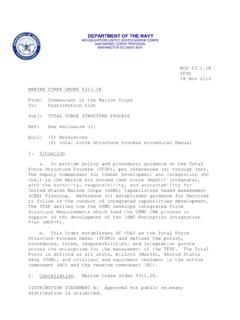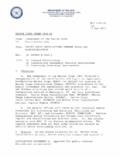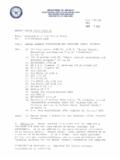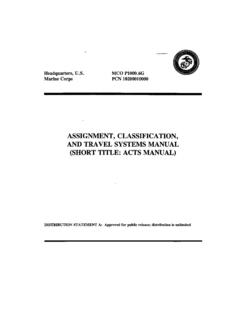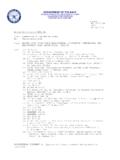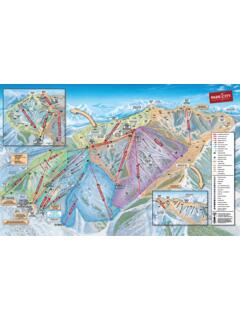Transcription of MCWP 3-11.3 Scouting and Patrolling - United States Marine ...
1 Scouting and PatrollingMCWP Marine CorpsPCN 143 000075 00 Distribution Statement A: approved for public release; distribution is unlimitedTo Our Readers Changes: Readers of this publication are encouraged to submit suggestions and changes that will improve it. Recommendations may be sent directly to Commanding General, Marine Corps Combat Development Command, Doctrine Division (C 42), 3300 Russell Road, Suite 318A, Quantico, VA 22134-5021 or by fax to 703-784-2917 (DSN 278-2917) or by E-mail to Recommendations should include the following information: Location of change Publication number and title Current page number Paragraph number (if applicable) Line number Figure or table number (if applicable) Nature of change Add, delete Proposed new text, preferably double-spaced and typewritten Justification andlor source of change Additional copies.
2 A printed copy of this publication may be obtained from Marine Corps Logistics Base, Albany, GA 3 1704-5001, by following the instructions in MCBul 5600, Ma- rine Corps Doctrinal Publications Status. An electronic copy may be obtained from the Doc- trine Division, MCCDC, world wide web home page which is found at the following universal reference locator: Unless otherwise stated, whenever the masculine or feminine gender is used, both men and women are included. DEPARTMENT OF THE NAVYH eadquarters United States Marine CorpsWashington, DC 20380-177617 April 2000 FOREWORD1. PURPOSEM arine Corps Warfighting Publication (MCWP) , Scouting and Patrolling ,provides the doctrinal foundation and the tactics, techniques, and procedures forscouting and Patrolling conducted by Marines from the fire team to the company the information focuses on infantry units, much of the information is alsoapplicable to combat support units that are assigned Patrolling SCOPEMCWP provides all Marines with the instructional material they need to buildthe skills necessary to become effective scouts and patrol team members.
3 Thispublication provides the fundamentals of Scouting and Patrolling and their relationshipto each other. It also addresses organizational structure of teams and patrols,thetraining required to develop teamwork, and reporting SUPERSESSIONMCWP supersedes Fleet Marine Force Manual (FMFM) 6-7, Scouting andPatrolling, dated 6 January CERTIFICATIONR eviewed and approved this DIRECTION OF THE COMMANDANT OF THE Marine LocL-' RHODESL ieutenant General, Marine CorpsCommanding GeneralMarine Corps Combat Development CommandDISTRIBUTION: 143 000075 00 TABLE OF CONTENTSPART I. SCOUTINGC hapter1. Fundamentals of Scouting1001 Purpose1-11002 Required Scouting Skills1-1 Chapter 2. Terrain, Maps, and Direction2001 Terrain Features2-12002 The Lensatic Compass2-12003 Stars, Sun, and Other Features2-52004 Range Determination2-6 Chapter 3.
4 Enemy Activity3001 Estimating Enemy Strengths3-13002 Interpreting Signs and Tracks3-13003 Knowing the Enemy3-2 Chapter 4. Daylight Scouting4001 Cover and Concealment4-14002 Camouflage4-24003 Individual Movement4-34004 Route Selection4_SChapter 5. Night Scouting5001 Night Vision515002 Appearance of Objects5-35003 Sounds5004 Smells and Touch535005 Clothing and Weapons5-35006 Concealment5-35007 Aids to Night Scouting5-45008 Aids to Night Movement5-45009 Locating and Plotting the Enemy at Night5-650010 Routes of Movement5-8 Chapter 6. Observing and Reporting6001 Observation Posts6-16002 Reporting6-2 MCWP Scouting Fire Team7001 Positioning7-17002 Locating Enemy Positions7-27003 Action With an Attacking Platoon7-27004 Action With an Enveloping Unit7-5 PART2. INFANTRY PATROLLINGC hapter8.
5 Fundamentals of Infantry Patrolling8001 Defmitions8-18002 Relation of Patrolling to Scouting8-18003 Purpose8-18004 Types of Patrols8-18005 Training8-28006 Keys to Successful Patrolling8-3 Chapter 9. patrol Organization9001 General Organization9-19002 Task Organization9-1 Chapter 10. patrol Preparation10001 Mission10-110002 Factors Influencing patrol Size10-110003 Commander's Duties10-110004 patrol Leader Duties10-2 Chapter 11. Movement to and Return from the Objective Area11001 Passage of Lines11-111002 Organization for Movement11-111003 Control Measures for Movement11-411004 Precautions at Danger Areas11-511005 Hide11-611006 Immediate Actions Upon Enemy Contact11-611007 patrol Leader's Action in a Developing Situation11-1011008 Return From Objective Area11-10 Chapter 12.
6 Reconnaissance Patrols12001 General Missions12-112002 Specific Missions12-112003 Types of Reconnaissance12-212004 Task Organization12-212005 Size of Reconnaissance Patrols12-3 Scouting and Patrolling12006 Reconnaissance Equipment .12-312007 Reconnaissance patrol Actions at the Objective Area12-3 Chapter 13. Combat Patrols13001 Task Organization13-113002 Equipment13-113003 Raid Patrols13-113004 Contact Patrols13-313005 Ambush Patrols13-313006 Security Patrols13-713007 Urban Patrols13-8 Chapter 14. Information and Reports14001 Reporting14-114002 Captured Items14-114003 Prisoners14-214004 patrol Report14-214005 patrol Critique14-2 Appendix A. patrol Warning OrderA-lAppendix B. patrol OrderB-iAppendix C. patrol Evaluation ChecklistC- 1 Appendix D. Ambush FormationsD-1 Appendix E.
7 AcronymsE- 1 Appendix F. ReferencesF-iPART I. SCOUTINGCHAPTER 1. FUNDAMENTALS OF SCOUTINGS coutinginvolves observing terrain andlor the enemy, and accurately reportingthose observations. Scouting requires proficiency in the use of weapons, coverand concealment, route selection, and skill in unobserved day or night PURPOSEW henan infantry unit is not actively fighting theenemy, it should be actively searching forthe enemy,which is the primary purpose of Scouting . The unitattempts to keep the enemy off balance while makingpreparations for further attacks. Physically locatingand keeping the enemy off balance are normallyaccomplished by small units ranging from a two-person Scouting party to a squad-size are sent out as scouts or as members of apatrol because the commander needs informationabout the enemy, terrain, and the location of friendlytroops.
8 The lives of the entire unit may depend uponthe success or failure of a scout or patrol and theaccuracy and timeliness of the report. The successofthe scout or patrol will depend upon their training,preparation by the commander, and understandingtheir mission and the commander's wage combat successfully, a commander musthave accurate, detailed, and timely information aboutthe enemy, the terrain, and adjacent friendly scouts and capably led patrols are amongthe most effective means the commander has foracquiring the information necessary to plan tacticalactions and make decisions in Scouting SKILLSTobe effective, a scout must be able to Recognize terrain features. Read a map and determinedirection. Practice and implement theprinciples of cover andconcealment.
9 Fully utilize movementand route selection. Know the enemy (estimate enemyunit compositionand strength). Observe and reportinformation accurately. Select routes and movethrough numerous types 2. TERRAIN, MAPS, AND DIRECTIONA scout must understand map symbols, identify elevations from contourintervallines, scale distance on a map, relate natural andman-made features shown on themap to the actual features on theground, plot a course from one point to another,and locate his current position. To relate a map to the actualterrain and itsfeatures, a scout must be able to orient it tothe ground using a compass, twopoints, a watch, and the sun or the TERRAIN FEATURESS incethe infantry works and fights on the ground,terrain ashore information that scouts gather andreport on is of great importance.
10 Hills,valleys, woods,and streams are the forms and growthscommonlyreferred to as natural land features. Artificial or man-made features include houses, bridges, and 2-1 shows some important terrain LENSATIC COMPASST hebest method of fmding direction, duringboth dayand night, is with a compass. The lensaticand M2 arethe two types of compasses issued toinfantry work on the same standard compass for general use in the MarineCorps is the pivot-mounted lensatic compass, so calledbecause azimuths are read through a magnifying lensin the eyepiece. Figure 2-2, on page 2-2, shows thelensatic compass and its nomenclature. The metergraphic scale on the side of the compass is 1:50,000,which is the most used scale in military mapping. Thegraphic scale is useful in the field as a straightedge, anaid in orienting the map, and a means ofreading mapgrid coordinates.
